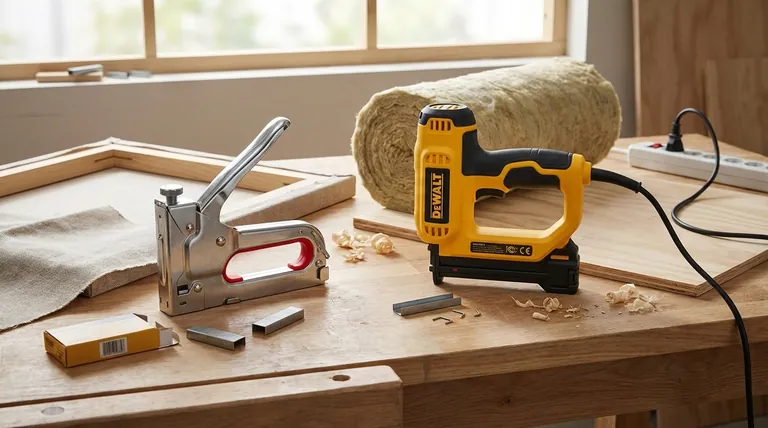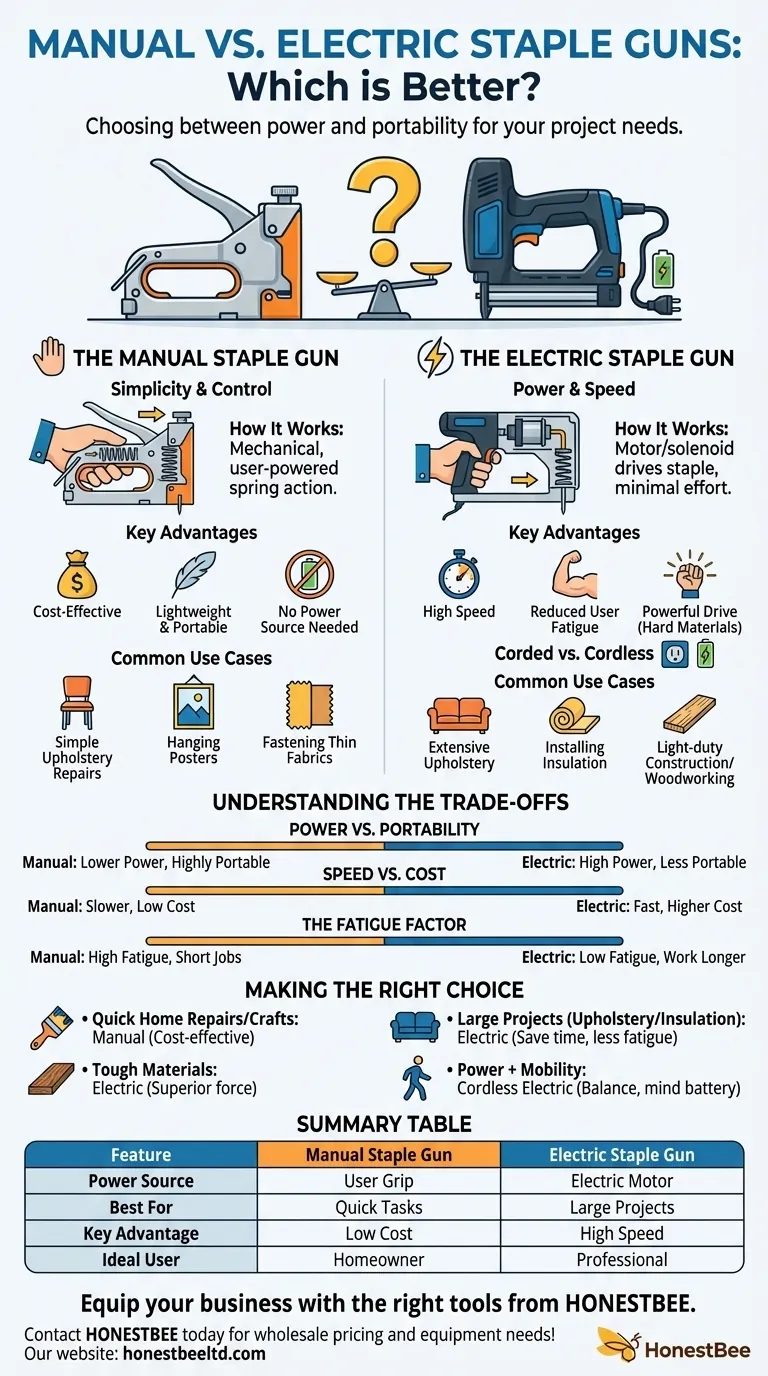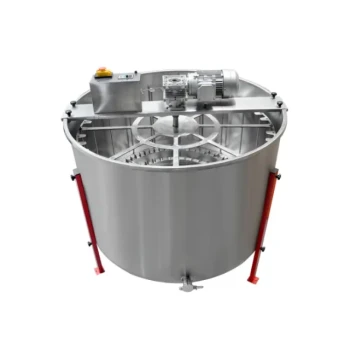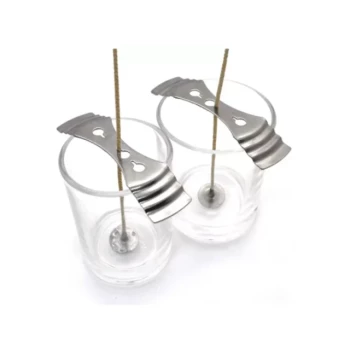Choosing the right staple gun is a decision that balances power against portability. While an electric staple gun delivers more power and speed for larger jobs, a manual staple gun offers unmatched simplicity and convenience for quick tasks and light-duty work. The "better" tool is the one that best fits the specific demands of your project.
The choice between manual and electric is not about which tool is superior overall, but which is the right tool for your specific application. Electric models excel at high-volume, repetitive tasks, while manual guns are perfect for portability and small-scale repairs.

The Manual Staple Gun: Simplicity and Control
A manual staple gun is the most basic form of the tool, valued for its straightforward design and reliability. It's an essential item for any basic home toolkit.
How It Works
The mechanism is entirely mechanical. Squeezing the handle compresses a powerful spring, which, when released, drives a staple with force. The user's grip strength directly contributes to the action.
Key Advantages
The primary benefits are cost and portability. Manual staplers are inexpensive, lightweight, and require no batteries or power cords, making them ready to use anywhere, anytime.
Common Use Cases
They are ideal for light-duty tasks like simple upholstery repairs, securing canvas to a frame, hanging posters, or fastening thin fabrics where only a handful of staples are needed.
The Electric Staple Gun: Power and Speed
Electric staple guns were developed to overcome the two main limitations of manual models: user fatigue and insufficient power for hard materials.
How It Works
An electric staple gun uses a motor or solenoid to drive the staples. The user simply pulls a trigger, and the internal mechanism does the work, delivering a consistent, powerful drive every time.
Key Advantages
The main advantages are speed and reduced fatigue. They can fire staples much faster than a manual model and require very little physical effort, making them essential for repetitive tasks. Their power also allows them to drive staples flush into harder woods and materials.
Corded vs. Cordless Models
Corded electric staplers offer unlimited, consistent power but are tethered to an outlet, limiting their range. Cordless models provide excellent portability but are dependent on battery life and are typically heavier.
Common Use Cases
Electric staplers are the tool of choice for larger projects. This includes extensive upholstery work, installing insulation, fastening carpet pads, and light-duty construction or woodworking tasks.
Understanding the Trade-offs
Choosing the correct tool requires you to weigh their core differences against the needs of your job.
Power vs. Portability
An electric staple gun provides significantly more driving force, which is non-negotiable for dense materials like plywood or oak. A manual gun may fail to sink staples flush in these cases. However, its cord or battery makes it less portable than a simple manual tool.
Speed vs. Cost
For a project requiring hundreds of staples, an electric model is exponentially faster and will save you significant time. This speed and power come at a higher initial cost compared to the very affordable manual stapler.
The Fatigue Factor
Attempting a large project with a manual staple gun will lead to significant hand and wrist fatigue. An electric model almost completely eliminates this strain, allowing you to work longer and more comfortably.
Making the Right Choice for Your Project
Evaluate your task against the strengths of each tool to select the right one.
- If your primary focus is quick home repairs or crafts: A manual staple gun is the most cost-effective and convenient choice.
- If your primary focus is a large project like upholstery or insulation: An electric staple gun will save you significant time and prevent hand fatigue.
- If your primary focus is working on tough materials: The superior force of an electric staple gun is necessary to ensure staples are driven correctly.
- If your primary focus is combining power with mobility: A cordless electric model offers the best balance, but be mindful of battery life for all-day jobs.
By matching the tool's capabilities to your specific goal, you ensure a professional result with the least amount of effort.
Summary Table:
| Feature | Manual Staple Gun | Electric Staple Gun |
|---|---|---|
| Power Source | User's grip strength | Electric motor (Corded/Cordless) |
| Best For | Quick repairs, light-duty tasks, crafts | Large projects, repetitive tasks, hard materials |
| Key Advantage | Low cost, high portability, simplicity | High speed, power, reduced user fatigue |
| Ideal User | Homeowner, crafter, for small jobs | Professional, serious DIYer, for volume work |
Equip your apiary or distribution business with the right tools from HONESTBEE. Just as the right staple gun ensures a professional finish, the right beekeeping equipment is crucial for success. We supply durable, high-performance beekeeping supplies and equipment to commercial apiaries and distributors through our wholesale-focused operations. Let us help you build a more efficient and productive operation.
Contact HONESTBEE today for wholesale pricing and to discuss your equipment needs!
Visual Guide

Related Products
- HONESTBEE 72 Frame Industrial Electric Honey Extractor for Beekeeping
- 40 Frame Commercial Electric Honey Extractor for Beekeeping
- HONESTBEE Advanced Ergonomic Stainless Steel Hive Tool for Beekeeping
- Premium Traditional Copper Bee Smoker with Bellows
- 10L Stainless Steel Electric Honey Press Machine
People Also Ask
- What should a beekeeper do after extracting honey from supers? A Guide to Harvest Management
- What are the advantages of automated honey extractors in terms of time efficiency? Boost Your Harvest Speed
- Why is preserving honeycomb integrity important, and how do automated extractors help? Boost Hive Health & Honey Yields
- How do automatic honey extractors function? Achieve High-Efficiency Honey Harvesting
- What are the advantages of automatic honey extractors? Scale Your Apiary with Unmatched Efficiency
















